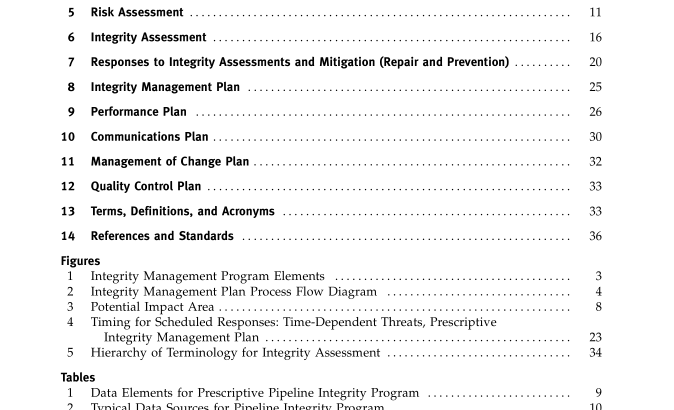ASME B31.8S-2001 pdf free download.Managing System Integrity of Gas Pipelines
1.1 Scope This Standard applies to onshore pipeline systems constructed with ferrous materials and that transport gas. Pipeline system means all parts of physical facilities through which gas is transported, including pipe, valves, appurtenances attached to pipe, compressor units, metering stations, regulator stations, delivery sta- tions, holders, and fabricated assemblies. The principles and processes embodied in integrity management are applicable to all pipeline systems. This Standard is specifically designed to provide the operator (as defined in para. 13) with the information necessary to develop and implement an effective integ- rity management program utilizing proven industry practices and processes. The processes and approaches within this Standard are applicable to the entire pipeline system.
1.2 Purpose and Objectives Managing the integrity of a gas pipeline system is the primary goal of every pipeline system operator. Opera- tors want to continue providing safe and reliable deliv- ery of natural gas to their customers without adverse effects on employees, the public, customers, or the envi- ronment. Incidentfree operation has been and continues to be the gas pipeline industry’s goal.
The use of this Standard as a supplement to the ASME B31.8 Code will allow pipeline operators to move closer to that goal. A comprehensive, systematic, and integrated integrity management program provides the means to improve the safety ofpipeline systems. Such an integrity management program provides the information for an operator to effectively allocate resources for appropriate prevention, detection, and mitigation activities that will result in improved safety and a reduction in the number of incidents.
This Standard describes a process that an operator of a pipeline system can use to assess and mitigate risks in order to reduce both the likelihood and consequences ofincidents. Itcovers both a prescriptive and a perform- ance-based integrity management program. The prescriptive process, when followed explicitly, will provide all the inspection, prevention, detection, and mitigation activities necessary to produce a satisfactory integrity management program. This does not pre- clude conformance with the requirements of ASME B31.8. The performance-based integrity management program alternative utilizes more data and more exten- sive risk analyses, which enables the operator to achieve a greater degree of flexibility in order to meet or exceed the requirements ofthis Standard specificallyin the areas of inspection intervals, tools used, and mitigation tech- niques employed. An operator cannot proceed with the performance-based integrity program until adequate inspections are performed that provide the information on the pipeline condition required by the prescriptive- based program. The level ofassurance ofa performancebased program or an alternative international standard must meet or exceed that of a prescriptive program.
The requirements for prescriptive- and performance- based integrity management programs are provided in each of the paragraphs in this Standard. In addition, Nonmandatory Appendix A provides specific activities, by threat categories, that an operator shall follow in order to produce a satisfactory prescriptive integrity management program. This Standard is intended for use by individuals and teams charged with planning, implementing, and improving a pipeline integrity management program. Typically, a team will include managers, engineers, operating personnel, technicians, and/or specialists with specific expertise in prevention, detection, and mit- igation activities.
1.3 Integrity Management Principles A set of principles is the basis for the intent and spe- cific details of this Standard. They are enumerated here so that the user of this Standard can understand the breadth and depth to which integrity shall be an integral and continuing part of the safe operation of a pipeline system. Functional requirements for integrity management shall be engineered into new pipeline systems from ini- tial planning, design, material selection, and construc tion. ASME B31.8S pdf download.ASME B31.8S-2001 pdf free download
